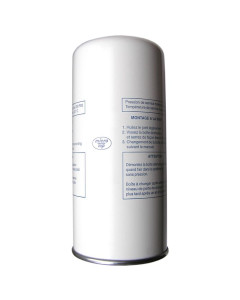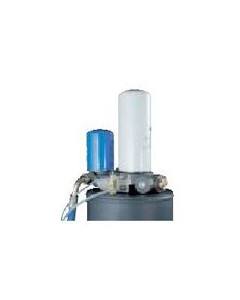Oil Separators for Screw Compressors: Essential Components for System Efficiency
Oil separators for screw compressors are fundamental components in industrial compressed air systems, specifically designed to remove oil particles from compressed air after the compression process. In screw compressors, oil performs multiple critical functions: it lubricates the rotors, seals the compression chambers, cools the system, and helps reduce noise during operation. However, this oil inevitably mixes with the air during compression, creating a mixture that must be processed to obtain quality air.
These separators use advanced physical principles of mechanical separation, such as centrifugal force, flow direction changes, and coalescence filtration, to efficiently capture oil particles suspended in the air. High-quality models can achieve separation efficiencies exceeding 99.9%, reducing residual oil content to less than 3 mg/m³ in the output air.
Technical Features and Components
A typical oil separator for screw compressors consists of:
- Separator element: Generally manufactured with special filtering materials such as fiberglass or synthetic materials with oleophobic treatments that facilitate the coalescence of oil particles.
- Housing: Designed to withstand working pressures of up to 15 bar or more, depending on the compressor specifications.
- Drainage system: Allows the recirculation of separated oil back to the compressor's lubrication system, minimizing losses.
- Differential pressure indicator: In advanced models, allows monitoring the condition of the separator element and determining when replacement is required.
Selecting the appropriate separator should consider parameters such as air flow rate, working pressure, compatibility with the type of oil used, and the specifications of the screw compressor manufacturer.
Key Takeaways: Oil Separators
- Essential components that remove up to 99.9% of oil from compressed air.
- Fundamental for protecting pneumatic equipment and ensuring air quality.
- Proper selection directly impacts energy efficiency and operating costs.
Importance and Benefits
Installing a high-quality oil separator in your screw compressor system provides multiple advantages:
- Equipment protection: Prevents oil from contaminating valves, pneumatic cylinders, and other tools, extending their service life.
- Air quality: Essential for applications requiring clean air such as painting, food processing, or pharmaceutical processes.
- Energy efficiency: A clogged separator increases pressure drop, raising energy consumption by up to 7%.
- Regulatory compliance: Helps comply with air quality standards such as ISO 8573-1.
- Reduced operating costs: Minimizes oil consumption by recovering it and returning it to the system.
Maintenance and Replacement
Proper maintenance of oil separators for screw compressors is crucial for maintaining system efficiency. It is recommended to:
- Periodically check the differential pressure across the separator.
- Replace the separator element according to manufacturer recommendations (typically every 2,000-4,000 operating hours).
- Verify that the oil drainage system is functioning correctly to prevent element saturation.
- Check compatibility with the oil used, especially when changing lubricant type or brand.
An increase in differential pressure greater than 10% of the nominal value or a detectable increase in oil in the output air are clear indicators that the separator requires immediate replacement.
Industrial Applications
Oil separators for screw compressors are essential in numerous industrial sectors:
- Manufacturing: For reliable operation of pneumatic tools and automated systems.
- Automotive: In production lines and paint shops where air quality is critical.
- Food and beverage: Where air must be free of contaminants according to health regulations.
- Pharmaceutical: In processes requiring high-purity air.
- Electronics: For the protection of sensitive components during manufacturing processes.
At Pneumatig.eu, we offer a wide range of high-quality oil separators for screw compressors, compatible with major manufacturers in the market, ensuring optimal performance of your compressed air system and protection of your pneumatic equipment.




Login and Registration Form